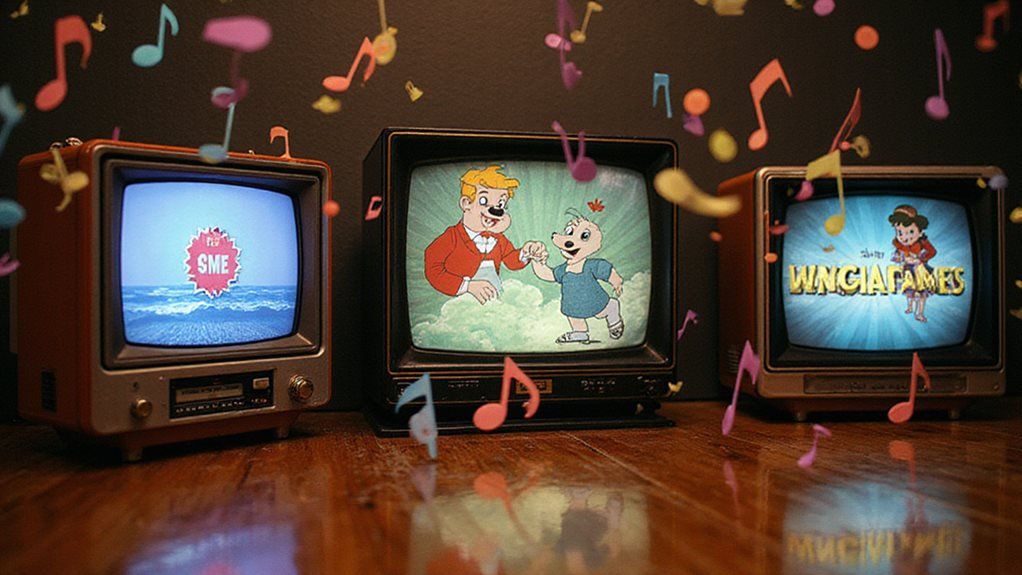Throughout advertising history, TV jingles have emerged as powerful tools for brand recall, shaping consumer perceptions and loyalties. Their memorable melodies and strategic placement in commercials create auditory imprints that linger in the collective psyche. From McDonald’s iconic “I’m Lovin’ It” to Coca-Cola’s melodic expedition, these jingles transcend cultural and generational boundaries. Understanding their impact raises intriguing questions about the elements that make a jingle timeless and practical in brand storytelling.
Key Takeaways
- McDonald’s “I’m Lovin’ It” jingle, launched in 2003, offers global brand recognition through its catchy melody and universal appeal.
- Coca-Cola’s “I’d Like to Buy the World a Coke” jingle from the 1970s evokes nostalgia and themes of peace and friendship.
- Folgers’ “The Best Part of Wakin’ Up” jingle has connected audiences through shared morning experiences and fostered enduring brand loyalty since the 1980s.
- Oscar Mayer’s jingle combines simplicity and nostalgia to resonate across generations, strengthening product recognition and brand loyalty.
- Pull-Ups’ “I’m a Big Kid Now” jingle fosters a sense of maturity and growth, targeting a critical childhood development stage.
The Power of Jingles in Brand Recall
Numerous studies have demonstrated that jingles possess a distinct ability to enhance brand recall, making them a valuable marketing tool. Recognized for their melodic hooks and memorable lyrics, the famous TV jingles of the past have effectively captivated audiences across generations. These auditory signatures not only bolster consumer recognition but also foster a heartfelt connection to the brand, creating a sense of belonging through shared cultural experiences. By incorporating simple, repetitive melodies, these jingles become embedded in the listener’s memory, creating an enduring impact that transcends language barriers. Brands like Oscar Mayer and Kit Kat demonstrated the potency of these mnemonic devices, ensuring they remain etched in consumer consciousness, underscoring the power of auditory persuasion in advertising innovation.
The Mesmerizing Magic of the McDonald’s Jingle
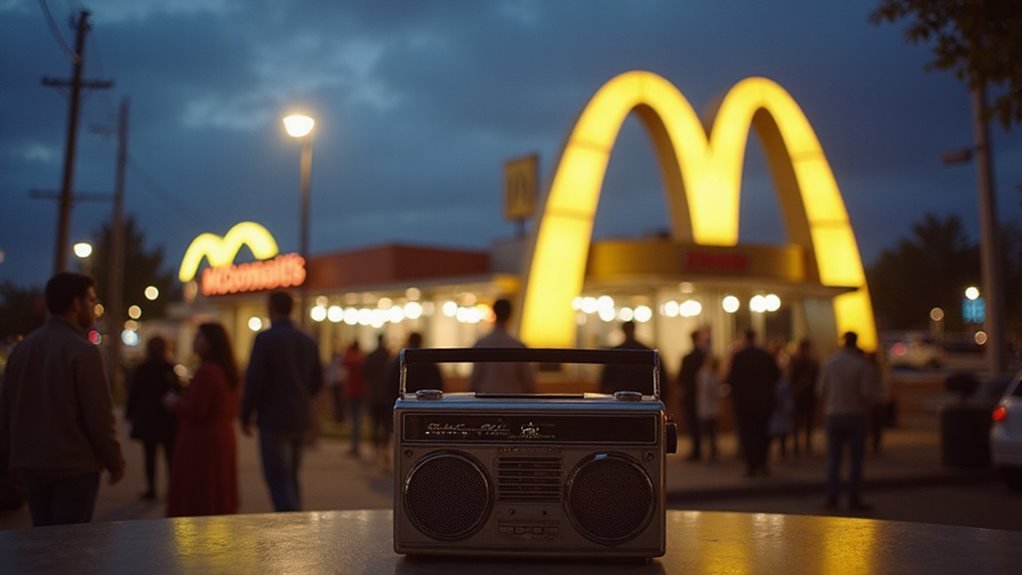
In the domain of iconic brand sounds, the McDonald’s jingle stands as a brilliant case study in the art of auditory marketing. Renowned for its sticky simplicity and memorable melody, the jingle has anchored McDonald’s advertising strategy, solidifying a profound connection with consumers. Each note acts as a gentle reminder of comfort and familiarity, traits that resonate deeply with audiences worldwide.
| Element | Description |
|---|---|
| Composer | Justin Timberlake and Pharrell Williams |
| Launch Year | 2003 |
| Signature Phrase | “Ba da ba ba ba, I’m lovin’ it” |
| Impact | Global recognition |
The magic of this jingle lies in its ability to transcend cultural barriers and generate a sense of belonging. Its universal appeal epitomizes the spirit of shared experiences, thereby amplifying brand loyalty and forging an indelible mark in advertising history.
Coca-Cola’s Catchy Melodic Journey
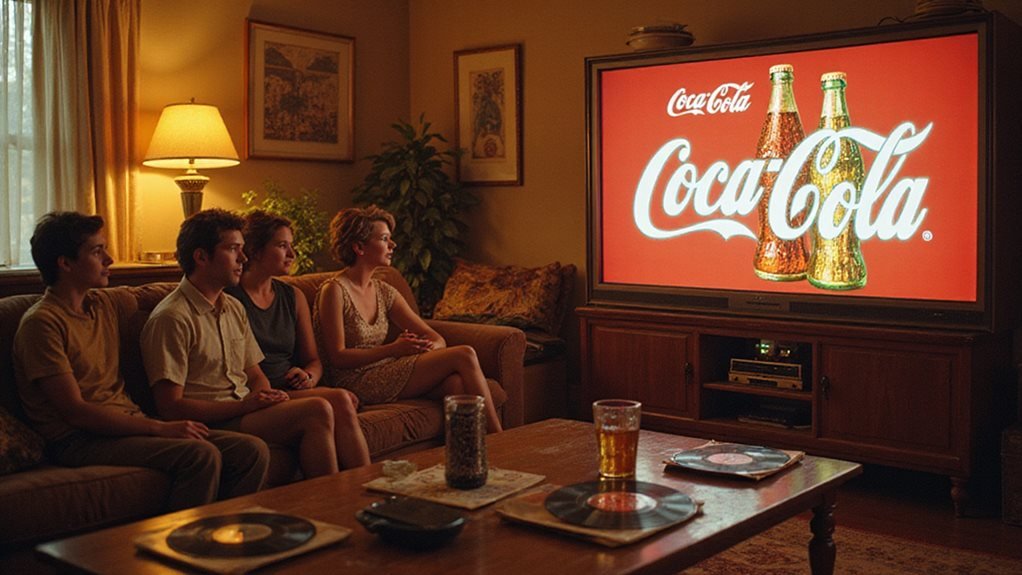
While tracing the history of commercial soundscapes, Coca-Cola’s melodic odyssey emerges as a quintessential example of how music can embed a brand into public consciousness. The expedition began in the 1970s with “I’d Like to Buy the World a Coke”, an anthem of unity and harmony, significantly altering the advertising landscape. This jingle capitalized on music’s emotive power to create a sense of global camaraderie among consumers, crafting an identity that transcended mere product promotion.
Critical elements contributing to its impact included:
- Nostalgia-inducing melodies that evoked feelings of warmth.
- Lyrics that resonated with themes of peace and friendship.
- Iconic television campaigns that became cultural benchmarks.
- Continued reverberation in collective memory through strategic revivals.
Coca-Cola ingeniously utilized these elements, embedding itself permanently in the societal fabric.
The Resounding Success of Nike’s “Just Do It”
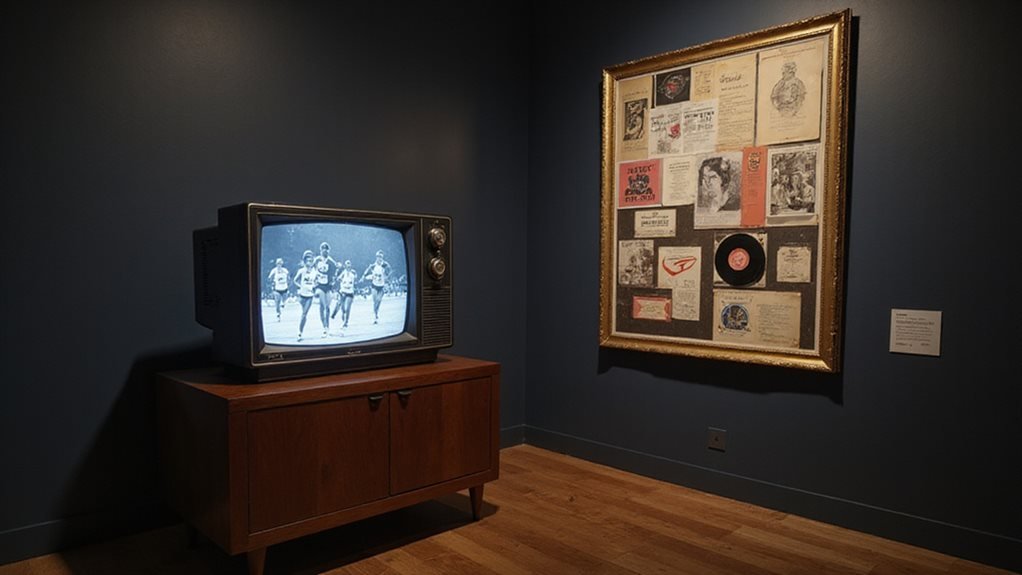
Nike’s “Just Do It” campaign epitomizes the power of strategic messaging in advertising. Launched in 1988, this slogan transcended mere marketing, embedding itself into cultural consciousness and inspiring millions globally. It distilled the essence of athleticism into three compelling words, appealing to both elite athletes and everyday people. The campaign’s genius lay in its simplicity, fostering a sense of encouragement and belonging, and encouraging everyone to overcome obstacles. This resonant message was married to engaging visuals and celebrity endorsements, thereby expanding its reach and impact. “Just Do It” is not merely a call to action—it is a communal ethos that unites a diverse demographic under a shared spirit of determination, illustrating how astute advertising can evoke a shared identity and ambition.
Apple’s Sonic Identity Revolution

Apple’s creativity in creating a coherent sonic identity marks a pivotal transformation in branding strategies, enabling sound to seamlessly integrate with a brand’s visual identity and enhancing consumer connection and recognition. Key to Apple’s success is its strategic use of sound cues that align with its minimalist aesthetic and imaginative ethos.
Apple’s sonic identity revolutionizes branding by melding sound with visual aesthetics, strengthening consumer bonds and recognizability.
- Distinctive auditory logo: Apple’s simple, six-note sequence is immediately recognizable and evokes a sense of sophistication.
- Integrated product sounds: From the startup chime to notification alerts, each auditory element aligns with the brand values of simplicity and elegance.
- Consistency across media: Whether in TV ads or retail spaces, Apple’s sound design guarantees a cohesive brand experience.
- Emotional resonance: Their sonic branding evokes a sense of community and shared tech-forward values, fostering loyalty among consumers.
The Sonic Impact of the Intel Jingle

The Intel jingle, with its iconic five-note melody, exemplifies the power of auditory branding in amplifying brand recognition. This brief yet memorable sonic element serves as a cognitive trigger, instantly evoking the Intel brand and its association with technological innovation across diverse global markets. The strategic use of these notes highlights how a simple auditory cue can deeply immerse a brand within consumer consciousness, enhancing both recall and perception.
Iconic Five-Note Melody
Consisting of merely five notes, the Intel jingle represents an outstanding blend of simplicity and memorability, illustrating the power of sonic branding. This iconic melody transcends the auditory domain, becoming deeply embedded in the collective cultural consciousness. The jingle’s effectiveness lies in the following characteristics:
- Simplicity: Each note is meticulously placed, creating a seamless and coherent trademark sound.
- Consistency: Across decades, it remains unchanged, sustaining brand recognition.
- Emotional Connection: The jingle evokes innovation, aligning with Intel’s technological narrative.
- Cultural Presence: It has permeated diverse forms of media, beyond traditional advertising.
Such a melody fosters a sense of belonging among consumers, allowing them to resonate with a tech-driven identity. In a continuously changing online environment, these five notes remain timeless, underscoring Intel’s industry influence.
Brand Recognition Amplified
When considering Intel’s sonic branding, it becomes evident that the five-note jingle is a masterclass in enhancing brand recognition through auditory cues. This succinct tune has transcended traditional advertising, becoming an integral part of global consciousness. Its introduction in 1994 was a strategic pivot, refining Intel’s image from a tech company to a household name. By crafting this ear-catching melody, Intel guaranteed that their auditory brand identity was seamlessly tied to innovation and trust. Research suggests that the jingle’s frequency and simplicity create an instant cognitive link between the sound and the product. In a symbiotic rhythm, this soundscape resonates with audiences who crave inclusion in the technological narrative. Consequently, the jingle does more than signify Intel; it forges a shared cultural experience.
How “I’m a Big Kid Now” Defined Pull-Ups

Encapsulating a pivotal moment in childhood development, the phrase “I’m a Big Kid Now” became a cornerstone in defining the Pull-Ups brand. It resonated with parents and children alike, symbolizing a shift from diapers to independence. This simple yet powerful jingle made a significant contribution to Pull-Ups’ identity, becoming deeply ingrained in the cultural consciousness. The effectiveness of this slogan can be analyzed through several key elements:
- Emotional Connection: It targets a critical developmental stage, encouraging both pride and growth.
- Memorable Catchphrase: The succinctness guarantees enduring recollection.
- Cultural Impact: It mirrored societal ideals of maturity and advancement, aligning with parental aspirations.
- Market Penetration: Solidifying Pull-Ups as the go-to brand for potty-training necessities.
Through these factors, “I’m a Big Kid Now” secured Pull-Ups’ prominent position in advertising history.
The Enduring Appeal of Folgers’ Morning Melody

Nostalgia plays a vital role in the enduring appeal of Folgers’ iconic jingle, “The Best Part of Wakin’ Up.” This catchy melody, introduced in the 1980s, has become more than just an advertisement; it serves as an auditory embodiment of the comforting ritual of morning coffee. The jingle’s widespread recognition demonstrates its success in connecting with audiences, invoking shared experiences, and fostering a collective identity centered around a universal morning routine. Its memorable yet straightforward tune reinforces Folgers’ brand image, while its repetition over decades embeds a sense of continuity and tradition in the consumer’s mind. By tapping into heartfelt resonance, the melody transcends simple promotion, instead creating a communal sense of warmth and familiarity that endures through generations.
The Nostalgic Charm of Toys “R” Us
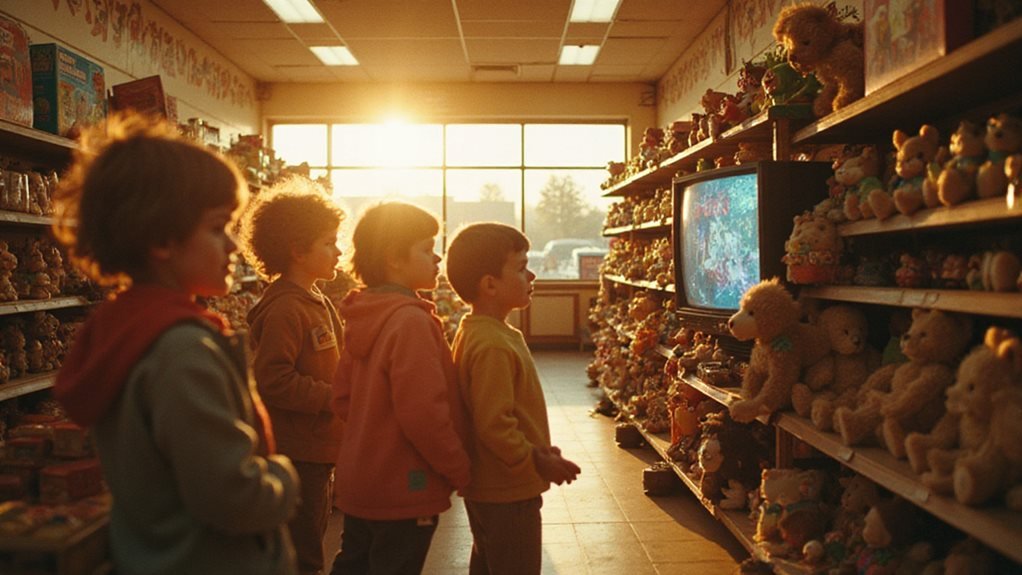
The Toys “R” Us jingle, with its memorable lyrics and singable tune, became an auditory symbol of childhood joy, making it an enduring piece of marketing history. Central to its appeal was Geoffrey the Giraffe, the brand’s charismatic mascot, who became synonymous with the wonder and excitement of toy shopping. This combination of catchy music and iconic imagery effectively engaged nostalgia marketing, tapping into the collective memory of consumers who grew up with the iconic store.
Catchy Jingle Lyrics
Amidst the pantheon of memorable TV jingles, the Toys “R” Us theme remains a hallmark of catchy melody and nostalgic pull. This jingle captivated audiences with its singable simplicity and emotive resonance, weaving itself into the cultural fabric of childhood memories. Its effectiveness lay in:
- Memorable Lyrics: The infectious refrain, “I don’t want to grow up, I’m a Toys ‘R’ Us kid,” encapsulated a yearning for the joy of childhood.
- Melodic Simplicity: The tune was constructed to be easily hummable, making it a lasting earworm.
- Emotional Connection: Evoking sentiments of wonder and innocence, the jingle fostered a sense of belonging.
- Cultural Impact: It transcended generations, becoming emblematic of childhood aspirations.
This jingle demonstrated the timeless power of melody in brand storytelling.
Iconic Brand Mascot
A pivotal element underscoring Toys “R” Us’s nostalgic charm is its iconic brand mascot, Geoffrey the Giraffe, who, through decades of interaction with the brand’s clientele, has become synonymous with childhood joy. Geoffrey embodies a lively spirit that connects generations of consumers with cherished memories of playtime. As a symbol, he fosters a sense of belonging and contributes to brand loyalty through his consistently cheerful and warm demeanor.
| Emotion | Memory Trigger | Consumer Connection |
|---|---|---|
| Joyful Excitement | Childhood Visits | Shared Generational Love |
| Nostalgia | Toy Unveiling | Unforgettable Bonds |
| Warmth | Family Outings | Community Feel |
Geoffrey’s presence in marketing campaigns harnessed the power of nostalgia, embedding fond memories while subtly encouraging a return to childhood wonder.
Nostalgia Marketing Impact
Often overlooked yet profoundly impactful, nostalgia marketing has been a crucial catalyst in reviving consumer engagement with brands that thrive on timeless appeal, such as Toys “R” Us. By tapping into the collective memories of past generations, Toys “R” Us effectively rekindles fond childhood memories. This strategy not only fosters a deep sentimental connection with the audience but also revitalizes brand loyalty.
Consider the following elements that contribute to this success:
- Familiar jingles evoke memories and sentiments, creating a nostalgic atmosphere.
- Iconic imagery tied to happy childhood experiences ensures the brand’s message resonates.
- Engagement through storytelling, inviting customers to rediscover past joys.
- Reintroduction of classic products, making the old feel new again.
Such tactics reinforce brand attachment, driving both current market presence and enduring affinity.
Oscar Mayer’s Memorable Branding Tune

Oscar Mayer’s memorable branding tune, recognized explicitly for its catchy and straightforward melody, emerged as a cornerstone of the company’s advertising strategy. This jingle, often identified by its memorable lyrics “My bologna has a primary name,” tapped into the collective memory of its audience, creating a heartfelt connection with consumers. It successfully utilized simplicity to become universally relatable, evoking a sense of nostalgia that resonated across generations. The tune’s repetition and engaging narrative structure made it easy to remember, ensuring Oscar Mayer a permanent place in advertising history. This strategic move reinforced product recognition and brand loyalty, offering a shared cultural reference point. In a constantly evolving market, this jingle exemplifies how music can transcend time, solidifying a brand’s identity within society.
Frequently Asked Questions
What Criteria Define the Success of a TV Jingle in Advertising?
A successful TV jingle seamlessly embeds into cultural consciousness through memorability, sentimental resonance, and brand association, fostering a collective connection among audiences. Its rhythmic and lyrical qualities guarantee widespread recall, ultimately enhancing product recognition and loyalty among consumers.
How Do Cultural Shifts Affect the Longevity of a Jingle’s Popularity?
Cultural shifts act as relentless tides, washing away outdated sentiments, thereby reducing a jingle’s resonance. As societal values evolve, nostalgia fades, leaving only adaptable melodies that harmonize with contemporary ideals to secure enduring popularity and a place in collective memory.
What Is the Cost of Producing a Memorable TV Jingle?
The cost of producing a memorable TV jingle depends on multiple factors, including composition fees, talent, studio costs, and marketing budget. Agencies often invest considerable resources, considering cultural relevance and audience connection, to ensure the longevity of jingles and brand association.
How Do Voice Actors Impact the Reception of Jingles?
Voice actors bring jingles to life with voices so powerful, they could move mountains. Their tone, clarity, and charisma significantly contribute to audience connection, making the jingle unforgettable and fostering a sense of community among listeners.
What Techniques Enhance the Emotional Connection in a Jingle?
To create a heartfelt connection in a jingle, employing catchy melodies, relatable lyrics, and memorable rhythms is a vital technique. Additionally, using voice qualities that convey warmth and familiarity fosters a more profound sense of belonging with the audience.
Conclusion
In the grand symphony of advertising, jingles emerge as timeless conductors, orchestrating brand narratives that linger far beyond their initial airing. These auditory lighthouses—McDonald’s joyful tune, Nike’s invigorating mantra, Folgers’ comforting melody—act as mnemonic devices that not only captivate but also cultivate loyalty. By seamlessly weaving sentimental resonance with brand identity, these jingles transcend mere commercial intent, embedding themselves into cultural consciousness and underscoring the inherent value of auditory brandingin the constantly changing marketing landscape.

Cary Reich is a master jingle-writer with over 35 years of experience creating brand‐defining melodic slogans and audio identities. Since 1985, Cary has crafted memorable campaigns for both national and local clients — including Budweiser, Firestone, Gold’s Gym, Goodwill, and YMCA — blending creative vision and musical expertise to make businesses not just heard, but remembered.

